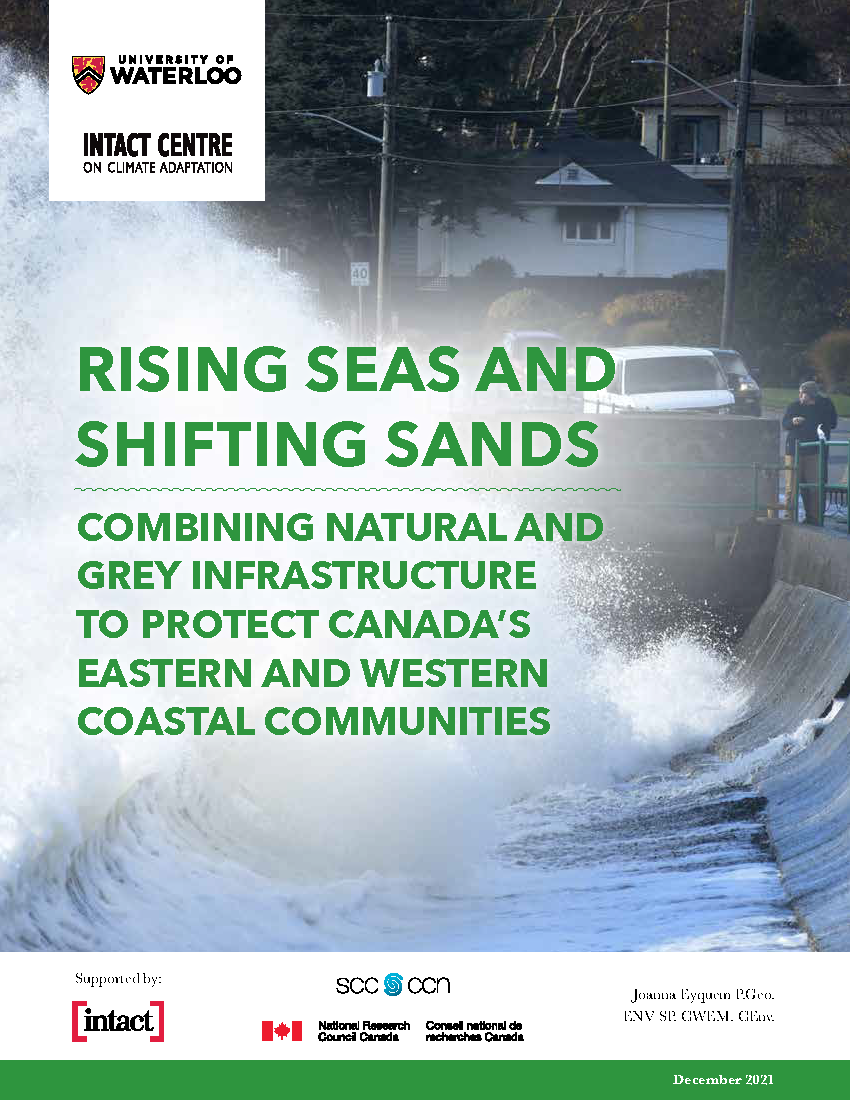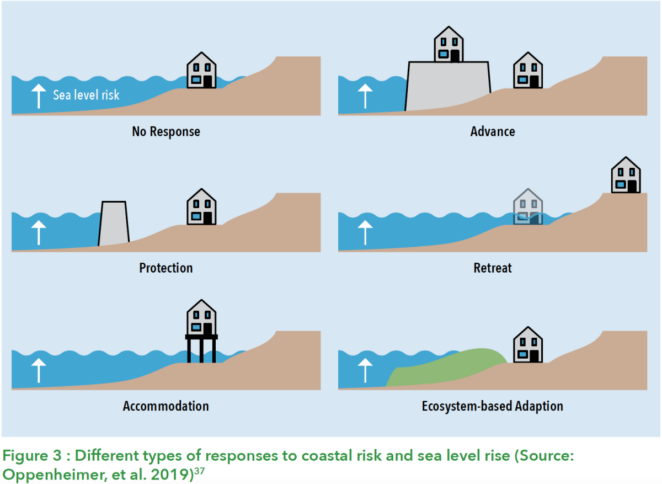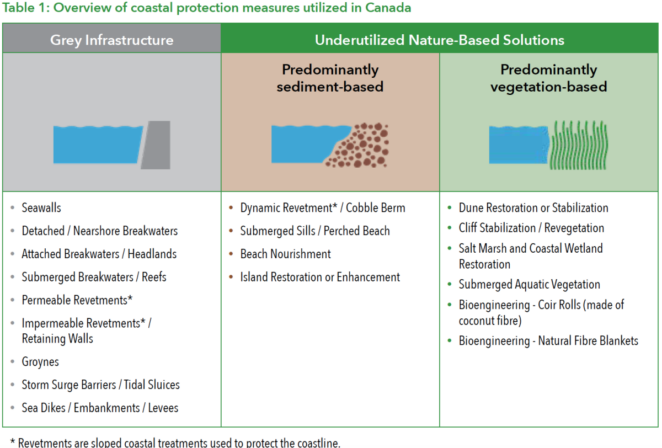Rising Seas and Shifting Sands: Combining Natural and Grey Infrastructure to Protect Canada’s Coastal Communities

Introduction
Coastal flooding and erosion are a direct threat to the health and safety of people living in coastal communities, and cause damage to local infrastructure and property. The majority of Canada’s coastal population are located along the East (Atlantic) and West (Pacific) coastlines, where sea levels are rising due to effectively irreversible climate change.Action is requiredto manage the growing risks to coastal communities.
Importantly, action must consider natural processes along the coast to a greater extent than has occurred to date. Reduction of flooding and erosion at one site, if not carefully designed, can cause instability further along the coast and degradation of coastal ecosystems on which communities depend.
Canada does not yet have a strategic planning framework or standard classification of approaches for coastal risk management. Coastal risk management responses identified by the Intergovernmental Panel on Climate Change (IPCC) include Protection, Accommodation, Retreat and Avoidance, as well as non-intervention. A suite of options should be appraised to select appropriate approaches along Canada’s East and West coasts.
This report describes how Canada can scale-up the use of nature-based solutions, in tandem with grey infrastructure, to protect communities along the East and West coastlines.
*This weADAPT article is an abridged version of the original text, which can be downloaded from the right-hand column. Please access the original text for research purposes, full references, or to quote text.
Methods and Tools
The article draws on international methods of coastal adaptation responses as well as case studies. The international coastal adaptation responses and trends identified by the IPCC are shown in Figure 3 below. The case studies provided insights into approaches to coastal risk management from the Netherlands, England, Japan, the United States of America and Australia.

Options for Coastal Protection Measures
Coastal protection measures can be divided into two key categories:
Grey Infrastructure: hard, engineered coastal protection measures, and;
Nature-Based Solutions: measures that depend on, or mimic, natural systems to manage flood and erosion risk,3 that may be a) predominantly sediment-based, such as adding sediment to beaches through beach nourishment, or b) predominantly vegetation-based, such as saltmarsh restoration.
Table 1 presents an overview of different coastal protection measures utilized in Canada according to the above classification. Each of the measures has associated advantages and disadvantages, and different measures can be combined to fulfill multiple objectives within coastal communities.

Nature-based solutions, in particular, have a vital role to play in managing coastal flood and erosion risk in Canada. International experience and guidance demonstrate that these measures not only provide protection against coastal flooding and erosion, they also deliver multiple benefits, including improved biodiversity, carbon sequestration and storage, enhanced wellbeing and opportunities for recreational activities.
Conclusions and Next Steps
Canada’s Eastern and Western coastal communities are exposed to flooding and erosion, that will become more frequent and intense as a result of climate change. Canada can use nature-based solutions, alongside grey infrastructure, to protect coastal communities along the East and West coastlines in a changing climate.
Nature-based solutions are currently an underutilized option. These measures can provide multiple co-benefits in addition to reducing coastal flooding and erosion risk, including:
- provision of food (e.g. fish and shellfish)
- climate regulation (through carbon sequestration and storage)
- air quality regulation
- water quality regulation
- provision of habitat promoting biodiversity
- assets for recreational activity
- provision of aesthetic values
- inspiration for culture, art and design
Three courses of action are recommended to scale-up the use of nature-based solutions for coastal protection in Canada:
- Develop national standards to support consistent evaluation of the benefits of nature-based solutions when comparing infrastructure options, including for coastal protection.This should include minimum requirements, regional-specific standards, engagement with Indigenous people and recommended methodologies for reflecting the financial value of benefits provided by nature-based solutions.
- Develop national monitoring standards for coastal protection measures, focused on nature-based solutions.This should include consideration of minimum monitoring requirements, as well as how monitoring should be tailored to document performance against project-specific objectives. Funding for long-term monitoring and engagement with Indigenous people could be considered as minimum monitoring requirements.
- Build capacity to finance and deliver nature-based solutions by engaging the private sector.Public-private partnerships can potentially assist in financing, delivering, monitoring, and maintaining nature-based solutions. The insurance industry can also assist in managing construction risks and offering innovative insurance products that provide funds to restore natural features protecting the coastline, should they be damaged during extreme events.
The outcomes of these actions will help governments and other organizations make robust management decisions regarding coastal flooding and erosion along Canada’s East and West coastlines.
Perhaps the greatest challenge in Canada, and globally, in preparing for climate change and sea-level rise along the coast, is a limited sense of urgency to act. For around the past 6,000 years, global sea-level has remained relatively steady.This makes the recent, comparably rapid rise in sea-level caused by human-induced climate change less easy to grasp. Decision makers in Canada must realize, sooner rather than later, that the sea level of the past will not be the sea level of the future, and prepare coastal communities accordingly.
Suggested Citation:
Eyquem, J. L. 2021. Rising Tides and Shifting Sands: Combining Natural and Grey Infrastructure to Protect Canada’s Coastal Communities. Intact Centre on Climate Adaptation, University of Waterloo.
Related resources
- Improving the resilience of UK coastal communities
- Tanzania: Ecosystem-based Adaptation
- The Coastal Hazard Wheel - a universal coastal adaptation language
- Building Climate Resilience in Comoros
- Building coastal resilience to reduce climate change impact in Tambon Klong Prasong, Amphur Muang, Krabi province, Thailand
(0) Comments
There is no content